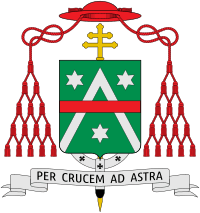Luigi Lavitrano
Luigi Lavitrano (7 March 1874 – 2 August 1950) was an Italian cardinal of the Catholic Church who served as Archbishop of Palermo from 1928 to 1944, and as prefect of the Sacred Congregation for Religious from 1945 until his death. Lavitrano was elevated to the cardinalate in 1929.
Luigi Lavitrano | |
|---|---|
| Prefect of the Congregation for Religious | |
Cardinal Lavitrano in 1939. | |
| Appointed | 14 May 1945 |
| Term ended | 2 August 1950 |
| Predecessor | Vincenzo Lapuma |
| Successor | Clemente Micara |
| Other posts | Cardinal-Priest of San Silvestro in Capite (1929–50) |
| Orders | |
| Ordination | 21 March 1898 by Francesco Satolli |
| Consecration | 21 June 1914 by Basilio Pompili |
| Created cardinal | 16 December 1929 by Pope Pius XI |
| Rank | Cardinal-Priest |
| Personal details | |
| Birth name | Luigi Lavitrano |
| Born | 7 March 1874 Forio, Kingdom of Italy |
| Died | 2 August 1950 (aged 76) Castel Gandolfo, Rome, Italy |
| Previous post |
|
| Alma mater |
|
| Motto | Per crucem ad astra |
| Styles of Luigi Lavitrano | |
|---|---|
 | |
| Reference style | His Eminence |
| Spoken style | Your Eminence |
| Informal style | Cardinal |
| See | Palermo (emeritus) |
Biography
Born in Forio, Lavitrano lost his entire family in an earthquake in 1883 that devastated the island of Ischia. He studied at the Pontifical Urbaniana University, the Pontifical Roman Athenaeum S. Apollinare, the Royal University, and the Pontifical Leonine Institute in Rome. He was ordained to the priesthood on 21 March 1898, and then taught at the Leonine Institute until 1910, when he became its rector. He was raised to the rank of Privy Chamberlain of His Holiness on 8 March 1904.
On 25 May 1914, Lavitrano was appointed Bishop of Cava e Sarno by Pope Pius X. He received his episcopal consecration on the following 21 June from Basilio Cardinal Pompili, with Bishops Giovanni Regine and Giovanni Scotti serving as co-consecrators. Lavitrano was later named Archbishop of Benevento on 16 July 1924, and finally archbishop of Palermo on 29 September 1928. In addition, he served as Apostolic Administrator of Castellammare di Stabia from 1924 to 1925.
Pope Pius XI created him Cardinal-Priest of San Silvestro in Capite in the consistory of 16 December 1929. Lavitrano, who once scolded Italian Catholics for their religious negligence,[1] was one of the cardinal electors who participated in the 1939 papal conclave that selected Pope Pius XII. After resigning as Palermo's archbishop in December 1944, he was made Prefect of the Sacred Congregation for Religious in the Roman Curia on 14 May 1945. Lavitrano's resignation was unexpected, and it is considered that he resigned because his alleged sympathy for the Fascists -- he voted for the National Fascist Party in the 1929 Italian general elections[2] -- became unpopular.[3]
Lavitrano died in Marino, in the Alban Hills, at age 76. He is buried in the basilica of Santa Maria di Loreto in his native Forio.
References
- TIME Magazine. Pope and Pastors February 10, 1940
- TIME Magazine. 98 28/100% Pure April 8, 1929
- Liberation: The Second World War in Sicily. Best of Sicily. Quote: "By a tradition dating from the medieval Norman rule of southern Italy, the Archbishop of Palermo is the Primate of Sicily. In modern times, this has entailed little more than a titular (and symbolic) precedence over other Sicilian bishops, but an important one. It was deemed inopportune for the Archbishop of Palermo (since 1928), Luigi Cardinal Lavitrano (1874-1950), who had been sympathetic to the Fascist regime, or at least perceived in that light, to continue in his position; General Patton's dislike of cardinal Lavitrano was well-known. Therefore, he 'resigned' to a post in the Roman Curia in December 1944. For a bishop to retire from active pastoral work at seventy years of age was unusual (the mandatory retirement age is now seventy-five), but in the case of this unforeseen wartime resignation - possibly the first of its kind in modern Italy - the Vatican did not have an immediate successor in mind. In fact, Ernesto Ruffini (1888-1967) was not appointed Archbishop of Palermo until October of the following year. Though conservative, Cardinal Ruffini was regarded as less reactionary and less monarchist than his predecessor."
External links
- Cardinals of the Holy Roman Church
- Catholic-Hierarchy [self-published]
| Catholic Church titles | ||
|---|---|---|
| Preceded by Giuseppe Izzo |
Bishop of Cava e Sarno 1914–1924 |
Succeeded by Pasquale Dell'Isola |
| Preceded by Alessio Ascalesi, CPPS |
Archbishop of Benevento 1924–1928 |
Succeeded by Adeodato Giovanni Piazza |
| Preceded by Alessandro Lualdi |
Archbishop of Palermo 29 September 1928 – 14 May 1945 |
Succeeded by Ernesto Ruffini |
| Preceded by Donato Cardinal Sbarretti |
Cardinal-Priest of S. Silvestro in Capite 1929–1950 |
Succeeded by Valerio Cardinal Valeri |
| Preceded by Vincenzo Lapuma |
Prefect of the Sacred Congregation for Religious 1945–1950 |
Succeeded by Clemente Micara |